Borneo Function – Vans & friends on the island of Borneo
31.07.2024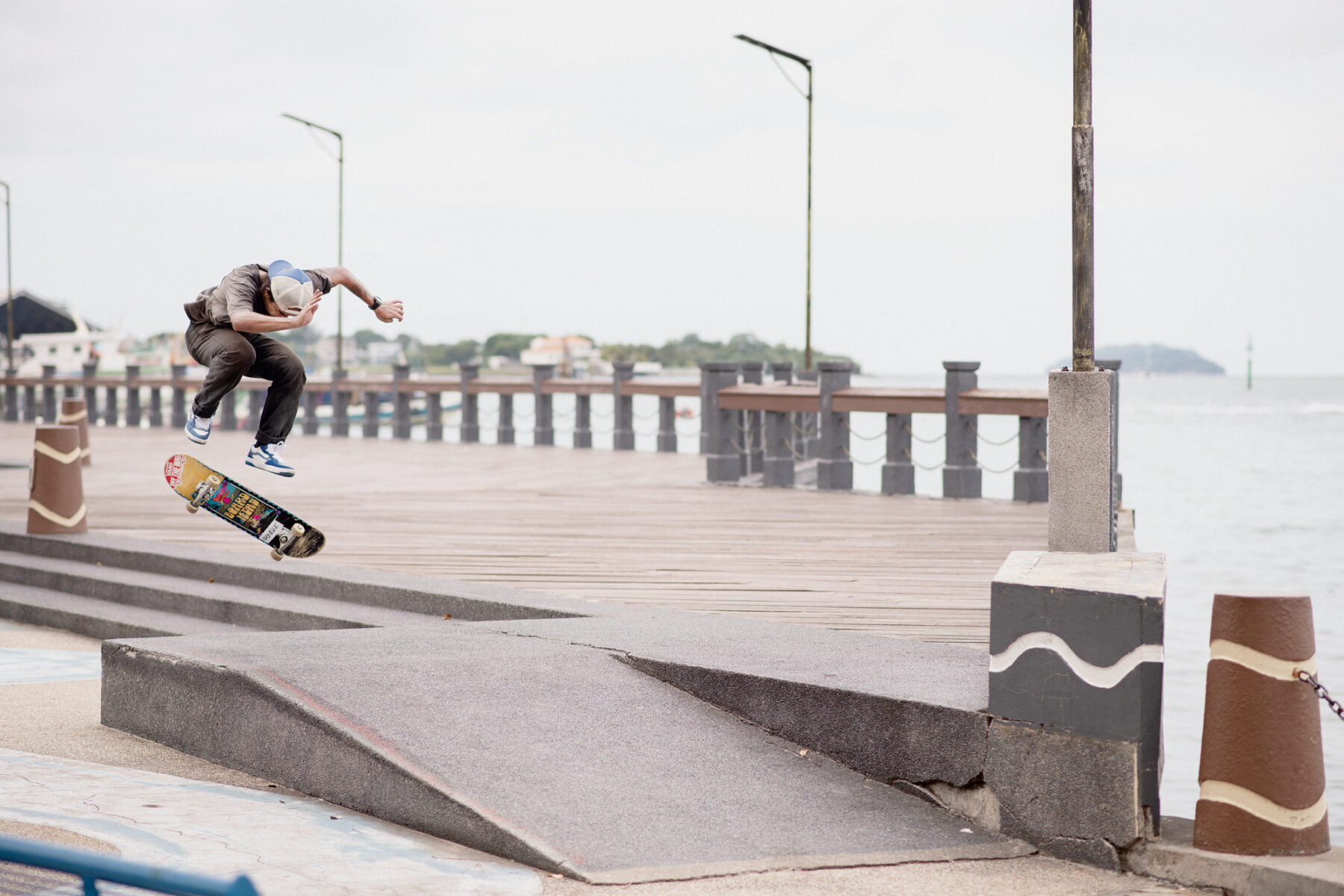
Photography & interviews: Genualdo Kingsford
An interview with professional skateboarder Porock Luis, who grew up in Sabah, and recently moved back to Kota Kinabalu from Kuala Lumpur.
Tell us about your home town, Kota Kinabalu.
KK is pretty chill and laid back, as opposed to the hustle and bustle of the city in Kuala Lumpur. Not too hectic. I like it here because it’s closer to my family. Although the skate scene here isn’t as hype as KL, it’s a work in progress, which I hope to contribute to by motivating others.
Tell us about the state of Sabah.
Sabah is truly a place for adventure! It’s known for having some of the world’s oldest rainforests, such as the famous Danum Valley and Maliau Basin, which have been around for 130m years. Sabah is also home to rare species such as the Borneo pygmy elephant, orangutan, proboscis monkey, sun bear, banteng and Sunda clouded leopard. The state is definitely blessed with natural diversity, unique cultures, fun adventures, beautiful beaches and fantastic cuisines for adventurous taste buds!
What are some local dishes a visitor should try?
You guys should try sago – locals call it ambuyat – or our rice wine called montoku.
What should a visitor tick off the list, in terms of sights and activities?
Surfing, snorkelling, hiking, diving and climbing the iconic Mount Kinabalu. The Kaamatan festival is worth checking out too.
Tell us a little about the history of skateboarding in KK.
I’m not really sure when and where it started, but I started skating around 2003 / 04. Skateboarders were seen skateboarding at red square for a while, before someone bought the place. After that, no one skated there because the guards really did their job well – sometimes they would fight you. But after the pandemic, finally we could skate red square again. They just don’t care any more; you can skate there whenever you want.
How is the skate scene in KK today?
Up and down because everybody has jobs, is studying or stopped skating because of family. Life’s a little bit hard here. We don’t have like big skate brands here for sponsorship and we don’t have a proper skate shop. Sometimes I see a kid getting good at skating, but suddenly they’re gone, just like that. I really try to help them by giving what I have, like used shoes and boards.
Are there any local brands you want to give a shout out to?
Shout out to Dumberhood, Run BKI, Death Machine and Empire Supplies – it’s not really a skate shop because they also sell football stuff, but they’re still very helpful to the community.
Who are some people important in maintaining the scene today?
There is no specific person. We as a community try our best to keep the scene alive.
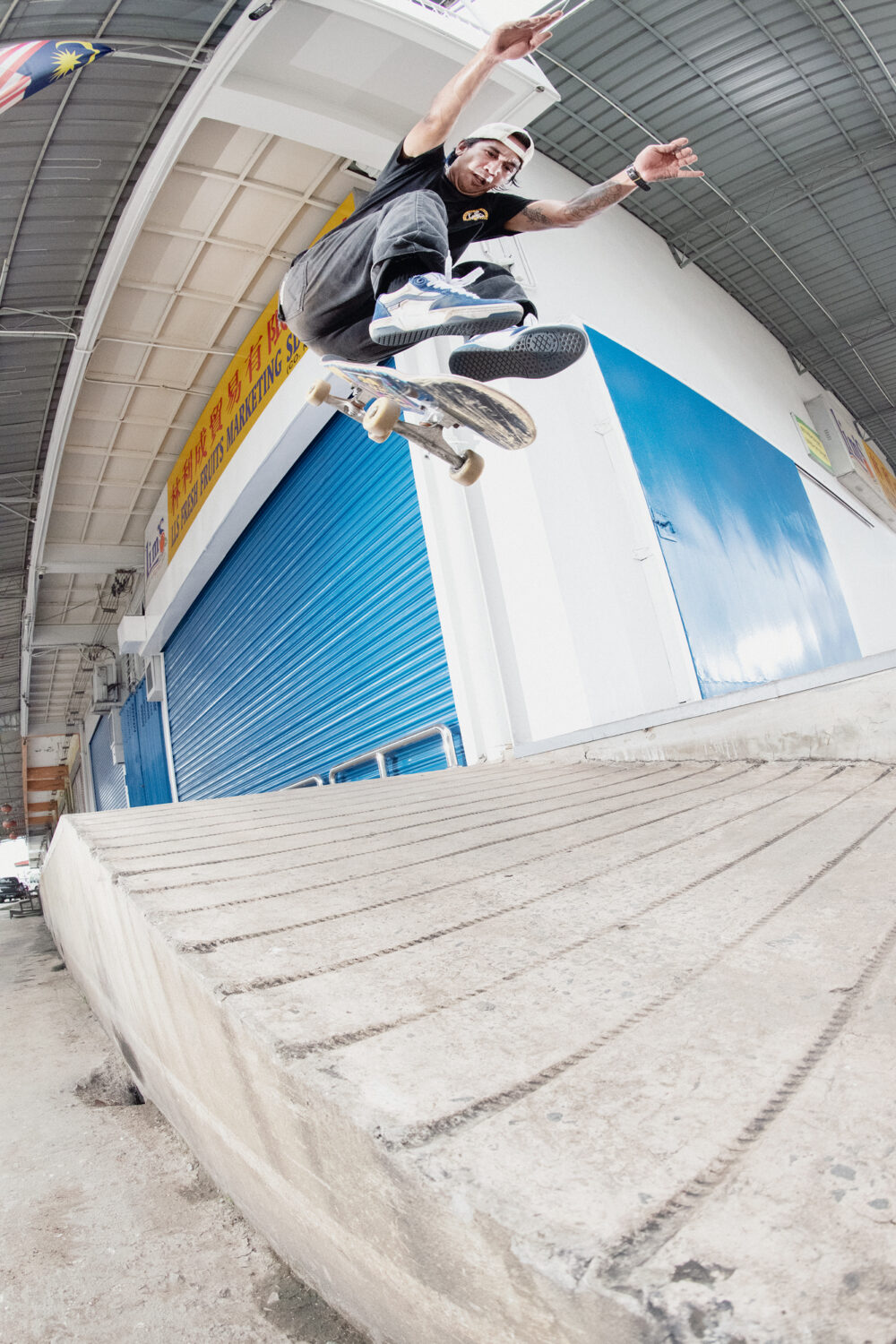
What are your favourite spots for a fun skate?
I really love skating the stage at red square. It feels like skating the LA Courthouse stage (laughs).
What spots should visiting skaters check out?
Red square, the kicker at big fish, the eight-stair handrail at Wisma Muis, the long small hubba at Kota Belud (a nearby town), the grass gap at Kolombong, plaza 88 and more. Just hit me up.
Who are some important local skaters people should know about, past and present?
Papa John, Fauzi SB, Greg (Cracko Art), Apip Ghani, Awyn, Khairi, Donald Yakyak, Pian, Apen, Mark 900, Maben (RIP), Collin, Mark Warren, Adib, Mimin, Rahman, Acak, Mark Narayang, Zul Gila, Eddie Menggatal, Imbie, Hamid, Yahya, Ilham, Kedo, Qais, Adeq, Ajil, Arwah, Babun, Haqem, Samsul Gigi, Pijan, Alip Pra, Joe Tattoo, Boy Glugut, Welson, Dennis, Richie, Linx, Aniq, Alvin, Boy Kangkang and all Borneo skaters.
Who are some younger, up-and-coming skaters people should look out for?
You guys should check out Alfin Sharul. People called him Ayok. He’s only 12 years old. He started skating at red square. He’s a very fast learner. I really hope one day this little dude can get what he wants in skateboarding, insya-Allah.
Do you think it’s harder to be a pro skater in KK than in Peninsula Malaysia? There seems to be a lot happening in Kuala Lumpur at the moment, in terms of events, parks videos etc.
It’s a bit hard, because when I lived in Kuala Lumpur I used to skate nine to five, but now there are no filmers or full-time skateboarders here, so it’s a bit demotivating. In terms of events, we have them, but not as big as in KL because our scene is still small.
What memories from our visit stand out?
Every moment for sure, because you guys are the first Europeans to visit KK just to skate and film.
Did any tricks that went down particularly impress you?
The big flip that Andrea did at big fish kicker was so good.
You recently became a father. Congratulations! How are you finding balancing skating with family life?
Alhamdulillah, thanks mate! Team-work makes the dream work! I am very grateful to have an understanding wife.
What are your hopes for the future of skateboarding in Kota Kinabalu?
I really hope that the scene will continue to strive and grow.
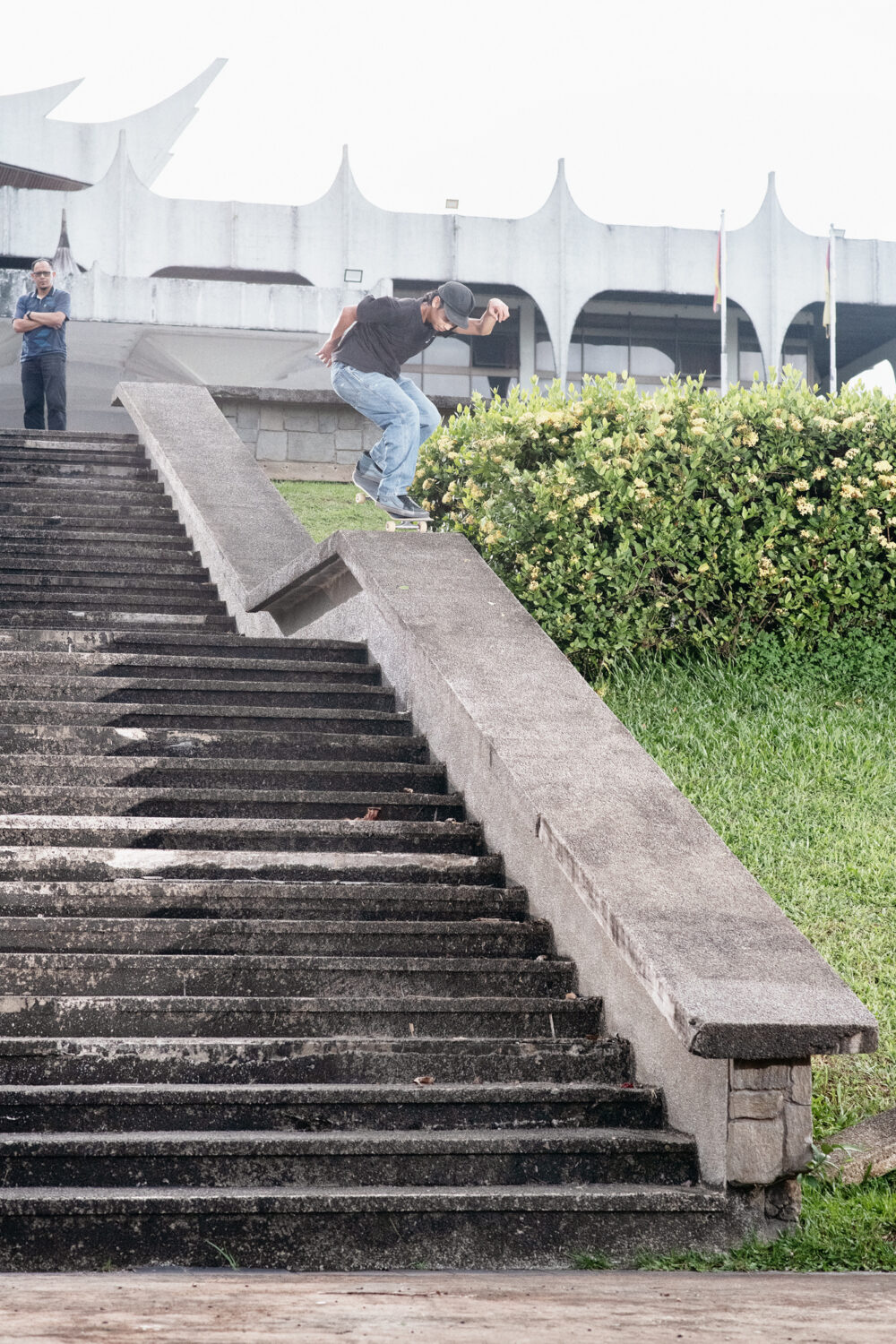
An interview with filmmaker Brandon Joel, who grew up in Kuching, Sarawak, and now resides in Kuala Lumpur.
Tell us about your home town, Kuching.
Kuching is located in the state of Sarawak on a little island called Borneo, east of Malaysia. The city is known for its diverse and multi-cultural society. Kuching is also known for the local food, deep rainforests and ethnic tribes unique to the region, and different from Peninsula Malaysia. This is evident from the most common physical difference: traditional tattoos.
Tell us about the state of Sarawak.
Sarawak man, there’s too much to say: all these indigenous cultures, their way of life in the jungles and mountains… You’ll have to come to find out (laughs).
What are some local dishes a visitor should try?
Definitely kolok mee and Sarawak laksa. There’s exotic food as well, if that’s your kind of thing. If you’re a drinker, don’t forget to try the local tuak and langkau.
What should a visitor tick off the list, in terms of sights and activities?
Visit the national park, I guess. But really though, make plans to visit the Airbnbs located up in the Borneo highlands (mountains, rainforests and hot springs), where you can get a real taste, interact with the local rural communities and get a glimpse of their simple and traditional way of life.
How was it growing up in Kuching?
Mellow and easy, because you’re surrounded by a lot of nature. Primitive way, man (laughs).
When did you move to Kuala Lumpur and what prompted that?
Hold on let me have a drink (takes shot). So I moved to KL in 2013 to further my studies. Cyberjaya, to be exact – which is in the state of Selangor – because it’s located close to PCP (Putrajaya Challenge Park), one of the biggest concrete transition parks in Malaysia. I dropped out in 2018 (laughs), and then I started focusing on filming.
How connected are you to the scene back home?
I’m quite well connected with the OGs. I look up to a lot of them. They’re like my father at this point (laughs). I’m also in a handful of group chats that send intel.
Tell us a little about the history of skateboarding in Kuching.
Skateboarding was very taboo and a subculture, an urban style of fashion. Back then, it allowed us teenagers to define ourselves. “Which group do we fit in?” “What kind of music do we listen to? Punk rock ka, hip-hop ka?” ‘Skater’ is an identification, a character lah. As Joseph Romey (KL-based skateboard teacher from Sarawak) put it: “You can enjoy different cultures or styles, but at the end of the day it brings people together. We don’t care what ethnicity, race or religion you are, we are skateboarders.”
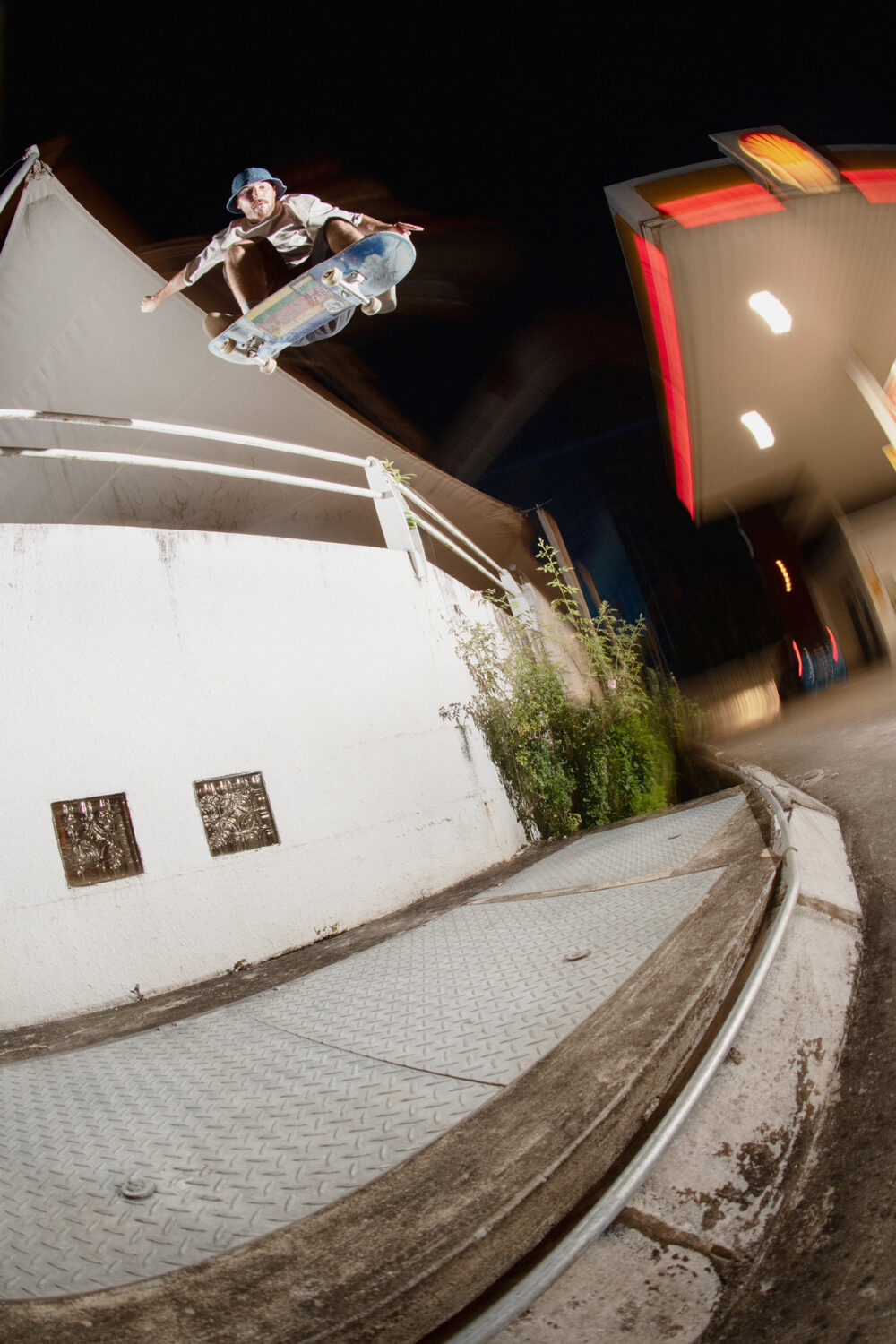
As for spots, Kuching used to have a couple of iconic ones like the library and Wisma Satok. Unfortunately both spots were taken down by the city. According to Hanafiah Hatari (Kuching local): “Back in the ’90s, you could say Kuching had better street spots and DIY parks than today.” Daryl Bucking recalled a quote from a fellow Kuching OG, Watt Ngumbang: “It was happening back in the days. You could easily see skaters skating everywhere around Kuching city. They would skate ‘tour’ around just to look for new spots, groups of 10-15 skaters going around the city, something that was noticeably fun and unforgettable, even today.”
How is the scene there today?
It’s alive and going. A bunch of new faces always pop up when I go back, so that’s good news!
You have put in many hours documenting skateboarding in Kuching. What motivated you to start filming?
The lack of videos from the city itself and knowing the amount of talent there. I just wanted to try to express skateboarding in the city of Kuching from my point of view.
Tell us about your videos.
I try to make independent videos featuring the locals and maybe some foreigners that come through Kuching or Kuala Lumpur. The last video I released was in the first half of 2023, so I’m just trying to stack clips now.
What is your favourite video project you have worked on?
In terms of editing, none, because I always feel I can do better. In terms of collaborating, I love doing the DIY stuff, like building concrete parks. Shout out to Bulldos crew!
Where can people watch your videos?
You can watch our videos on our Youtube channel. Just type in Paraidigma.
Are there any local brands or shops you want to give a shout out to?
Shout out to Libraryz Skateshop, Rupert Rage, Skate and Coffee, Bellboy96k and Rad.myy.
What are your favourite spots for a fun skate?
A spot I grew up skating, the Tabuan Jaya public park with tiled benches, a five-stair, a couple of grass gaps, a mellow bank on the side and red brick ground, and the new Borneo Museum spot in the heart of Kuching city, which has a couple of long granite ledges, smooth tiled ground, a gap and a curved slappy curb. It’s hard to miss because it’s right below where the new Borneo (Cultures) Museum is located.
What spots should visiting skaters check out?
Spots along the Kuching waterfront, the crusty steep transition and steep banks at 7th Mile (Hi Bread coffee shop), the steep volcano at MJC and Pangkalan Sapi, where there’s a bunch of skateable things like ledges, benches and gaps. Basically, check out the whole city.
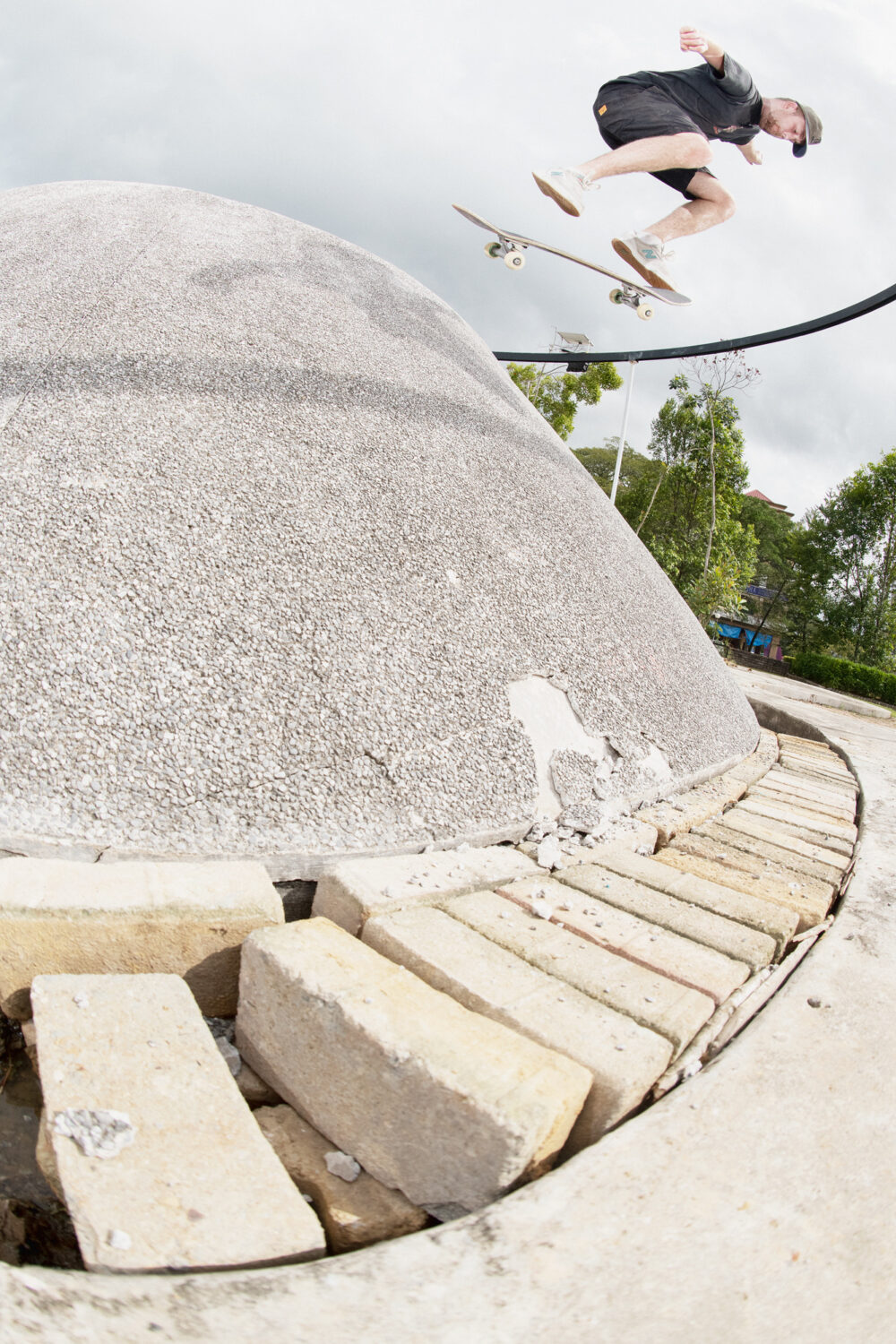
Who are some important local skaters people should know about, past and present?
Watt Ngumbang and Zul Posa from the ’80s. Joseph Romey, Hardy Barnabas, Hanafiah Hatari, Alvin Gamar, Jerry Ho, Joshua Caesar, Zharif Tazudin, Part Vicious, Daryl Bucking and Donald Gani from the ’90s. More recently, like the past 10 years: Gadd Francis, Atai Richardo, Ashraffi Anderson and Gavin Nuek. Respect to these Gs!
Who are some younger, up-and-coming skaters people should look out for?
David Adam, Lionel Daniel, Pius Elli, Nazwan Jarznie, Lias Ghazali, Wandy (Fazwan Nirwady), Ezra Syah and Gavin Nuek. Also, Abib Rahman and Luqman Hakim from Sibu, and Carlson Kuek and Firdaus Marzuki from Bintulu.
Did any tricks that went down during our time in Kuching particularly impress you?
Casey’s nollie backside flip on the MJC volcano, Andrea’s huge gap ollie at the gas station, Don’s nose manual drop on the crusty hubba and Conor’s wallie off the massive barrier into the road.
You joined Conor, Casey and Don for an overnight stay in the jungle. Tell us about that trip.
It was all mellow, but there was this one time when we rode in the back of a truck; it was so bumpy, and this crack dealer was telling me stories about how he did his ‘dirty things,’ while pouring shots at the same time, all the while the back of the truck was rollercoastering up and down on these dirt slopes.
What are your hopes for the future of skateboarding in Kuching?
I hope everyone keeps skating and searching for spots, and the rest will manifest.
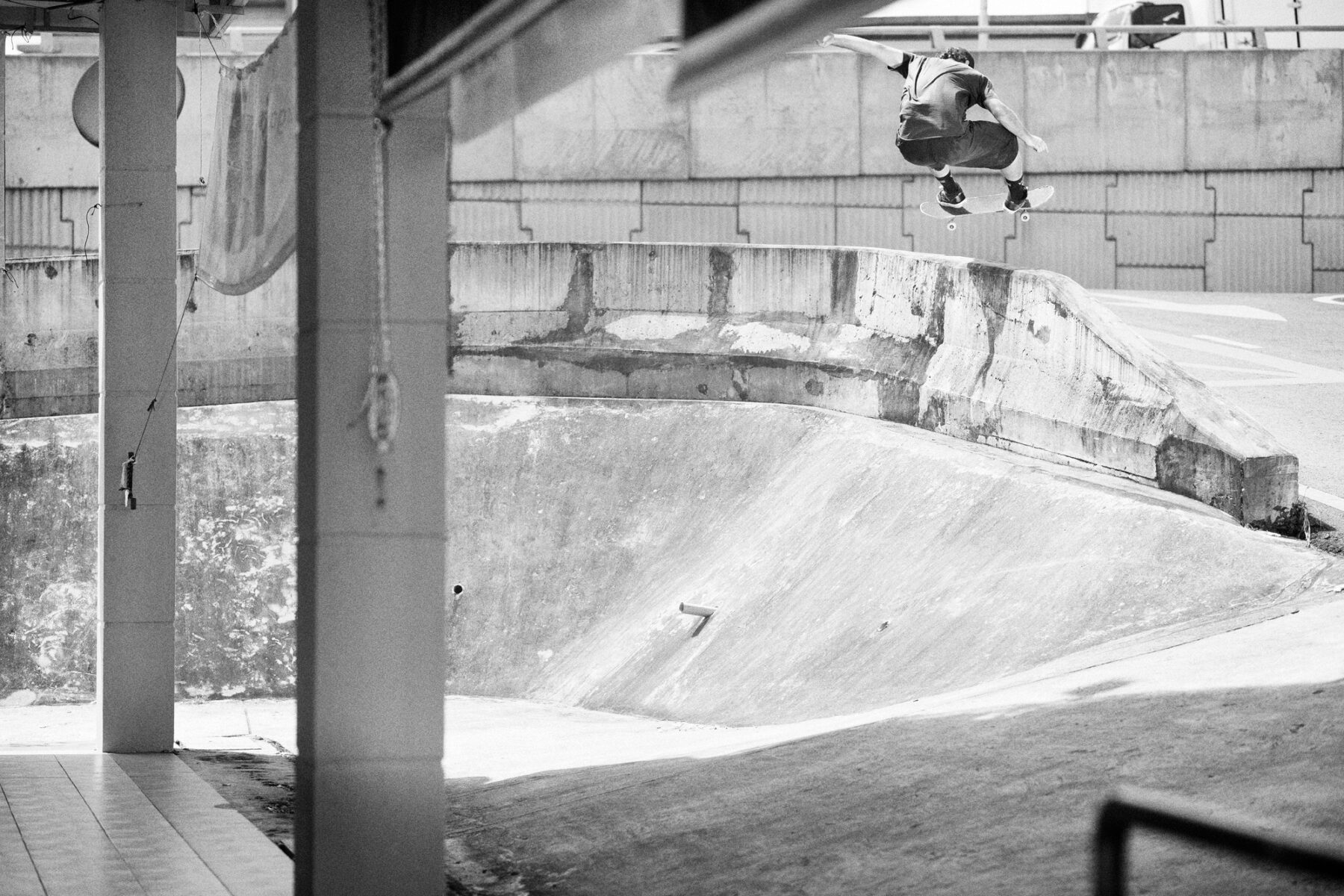
An interview with skateboarder and zoology enthusiast Conor Charleson, who organised our trip to Borneo.
Tell us how this trip came about.
It was sort of a bastardised version of my dream trip, which after a lot of research, simply might not be possible. I wanted to drive from Kota Kinabalu, a city in Sabah in Malaysian Borneo, westward along the northern coast of the island, finishing in Kuching in the state of Sarawak. I wanted the trip to take about a month, and stop off in all the smaller cities along the coast to skate, and dip into the jungle for a few days here and there for hikes because it had been a while since I had had a chance to do any zoological adventuring. However, driving that distance is no joke. I was told the roads aren’t great, tropical storms can pop up at any time and there’s no car-rental service that lets you pick up in one city and drop off in another. So instead, determined to achieve something quickly after putting out the part (Conor Charleson’s Slight Inclination) with Dan (Magee), I planned to visit mainland Malaysia for a couple of weeks to catch up with Don, Nizam (Hisham) and everyone else I know over there, then dip over to Kota Kinabalu, before flying to Kuching.
The zoological component of this trip didn’t work out quite as planned. Can you explain?
I think it was just bad planning on my part. I think the wildlife has to take priority in future, as it just seemed to get pushed aside to make room for more skateboarding. Also, I think I would trust my knowledge a little more and make sure I’m aiming for areas of ancient, untouched jungle.
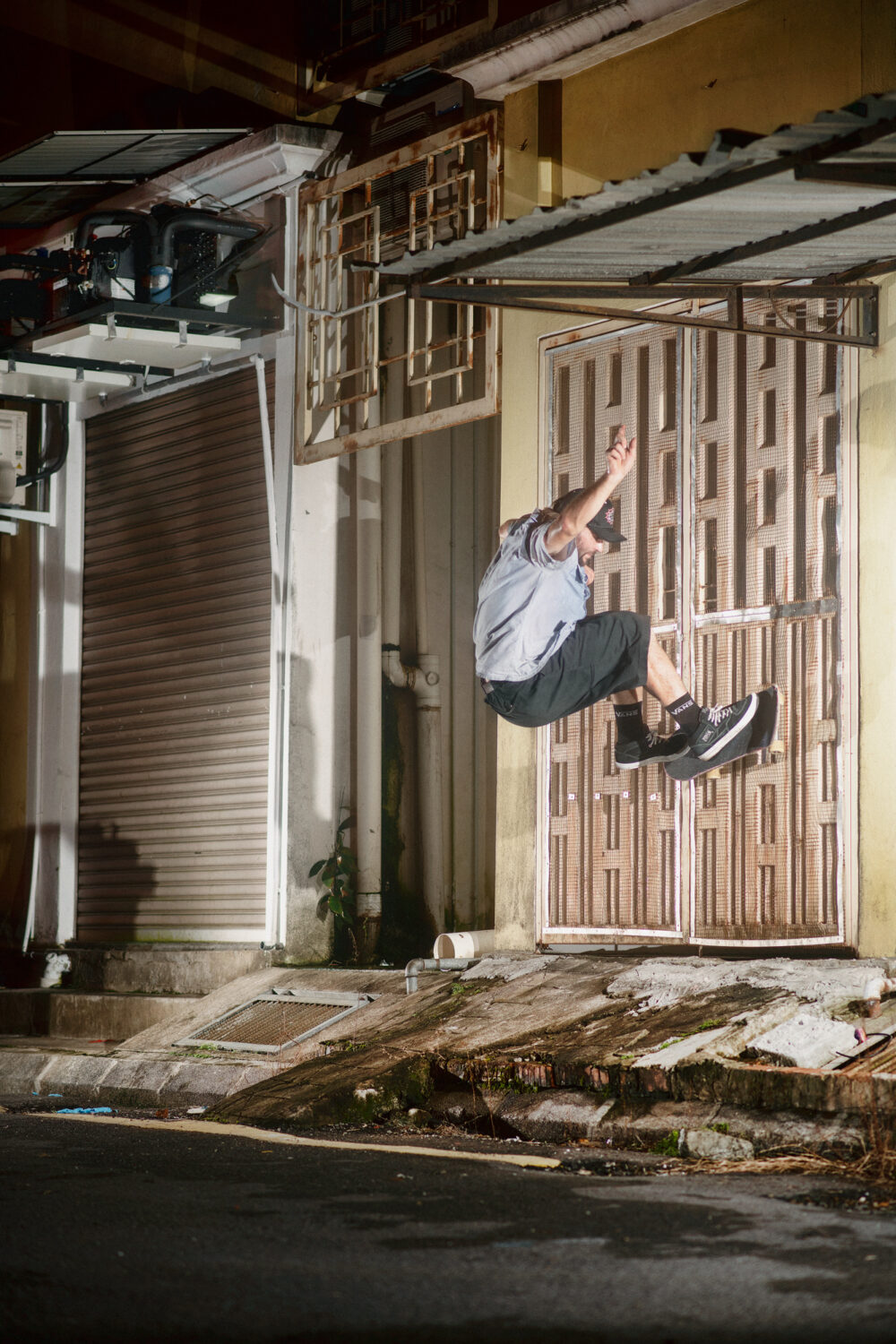
Tell us about the trip to the jungle outside Kuching.
I spent months chatting to Valentino (Ngabong), an outdoorsy Sarawak local Porock put me in touch with. He spoke to his friends, sorted cars to get us into the jungle and somewhere to stay, and then the day before the trip, you bailed, and so did Andrea. Scared of the snakes or something. So me, Don and Casey – who are definitely the hardest – were jammed into 4x4s. We picked up more local dudes, one of whom hopped on a motorbike and guided us through the most hectic drive up and down muddy trails and through rivers. When we arrived, we discovered that the area was indigenous land owned by Bidayuh people. This area of the forest had been felled to make room for houses. Instead of a deep jungle jaunt, litres of locally brewed tuak and langkau were laid on the table, and the night was focused around drinking and smoking as much as possible. We had a couple of jaunts to a small waterfall nearby, where I saw a few frogs and a couple of freshwater shrimp, but that was as wild as it got. Although it wasn’t quite what I was after, it was a lovely couple of days getting to know the guys, walking the local hunting route, cooking and eating with them and sharing their booze.
An earlier jungle excursion ended in a medical emergency. Tell us about that.
We had arrived from Kota Kinabalu the night before and decided to have a day off to visit an orangutan conservation centre just outside Kuching. I’m usually pretty wary of conservation centres, however, this one (Semeng-goh) had positive reviews regarding its management. The orangutans were well cared for. They had acres of jungle to roam, with ample fruit trees. We stood and stared into the jungle, in front of a few feeding areas that were nestled in the trees, while the staff called the apes down to feed, howling into the dense forest. We waited. And waited. Some giant ants became the centre of attention for a little while. We continued to wait, the howls echoing around us in the jungle, until finally, we gave up and went home. Apparently it was fruiting season, so the orangutans had no need to come to the rangers for food.
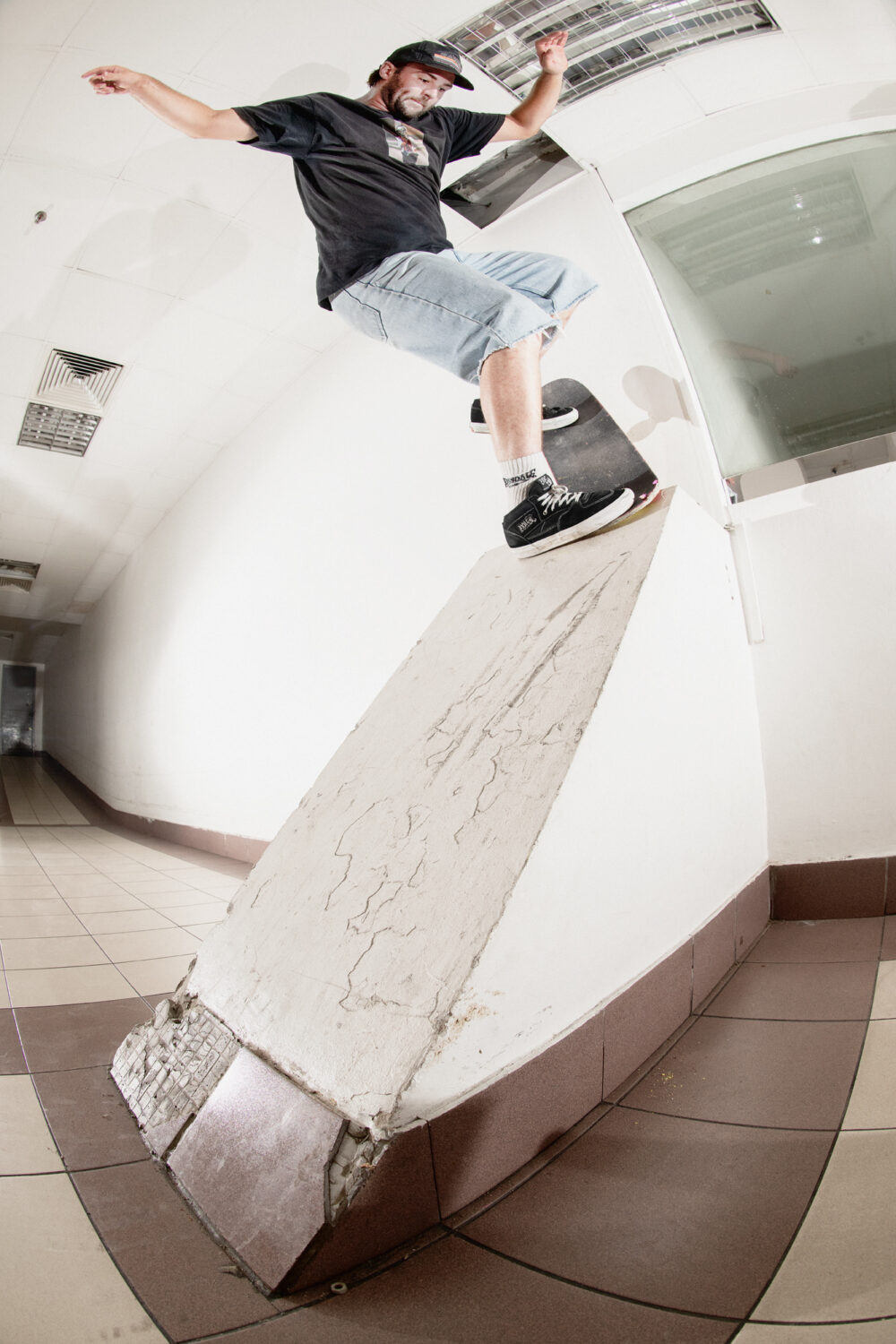
Along the path back to the entrance, we found a few fallen jackfruit. Brandon picked one up and cracked it open for us all to try. Casey immediately spat his on the floor, while I tried to smile through the taste of fermented popcorn with a texture unlike anything else I’ve ever eaten. Andrea was hesitant at first, but then his curiosity got the better of him. He plopped one of the rancid chunks into his gob and saw it through, but didn’t go back for seconds. “I am feeling like some itching,” he said, rubbing his throat. Brandon told him it was normal; something in the jackfruit irritates the throat, similar to pineapple. We continued to walk to the edge of the forest. Andrea was starting to get a little more stressed. The itching was intensifying and he was sure something serious was happening. We bought him a Sprite – there was no water – and split into our two cars. I didn’t hear anything more until I got a call from you as we arrived back at our apartment. As you guys were driving back, Andrea’s face started to balloon and you rushed him to a nearby clinic. As soon as he walked in the door, they whipped his pants down and whacked an Epipen’s worth of adrenaline into one of his arse cheeks.
Fun times. Do any other memories from our time on Borneo stand out?
Belting out country tunes with the band in Borneo Rednecks bar was pretty nice. The boat trip around the wetlands was sick too: seeing all the mangrove trees, catching glimpses of proboscis monkeys and saltwater crocs, watching beaches full of mudskippers fleeing to the water as we approached… Watching Don repeatedly telling a 21-year-old meth dealer that he was Muslim and didn’t drink when offered a bottle every five minutes in the back of a jeep on the long drive back was pretty entertaining.
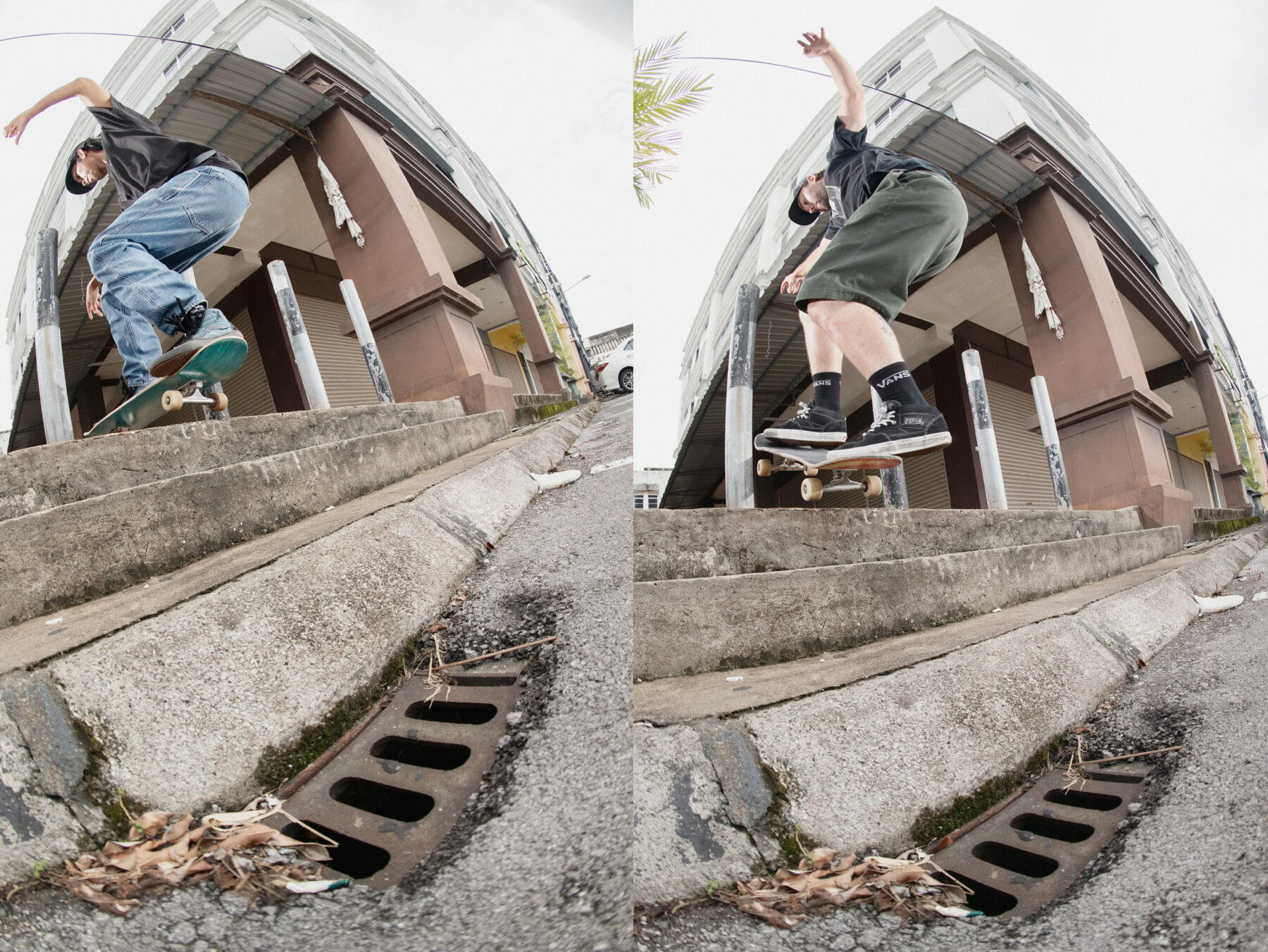
We would like to thank the following people for making our trip to Borneo possible: Casey Brown, Conor Charleson, Alan Glass (Independent), Hilman Hamdi, Nizam Hisham, Don Irfan, Brandon Joel, Porock Luis, Amanda Pérez (Vans) and Johnson Hwong. Special thanks to Andrea Dupre for filming the accompanying video. Apologies to anyone we forgot.
